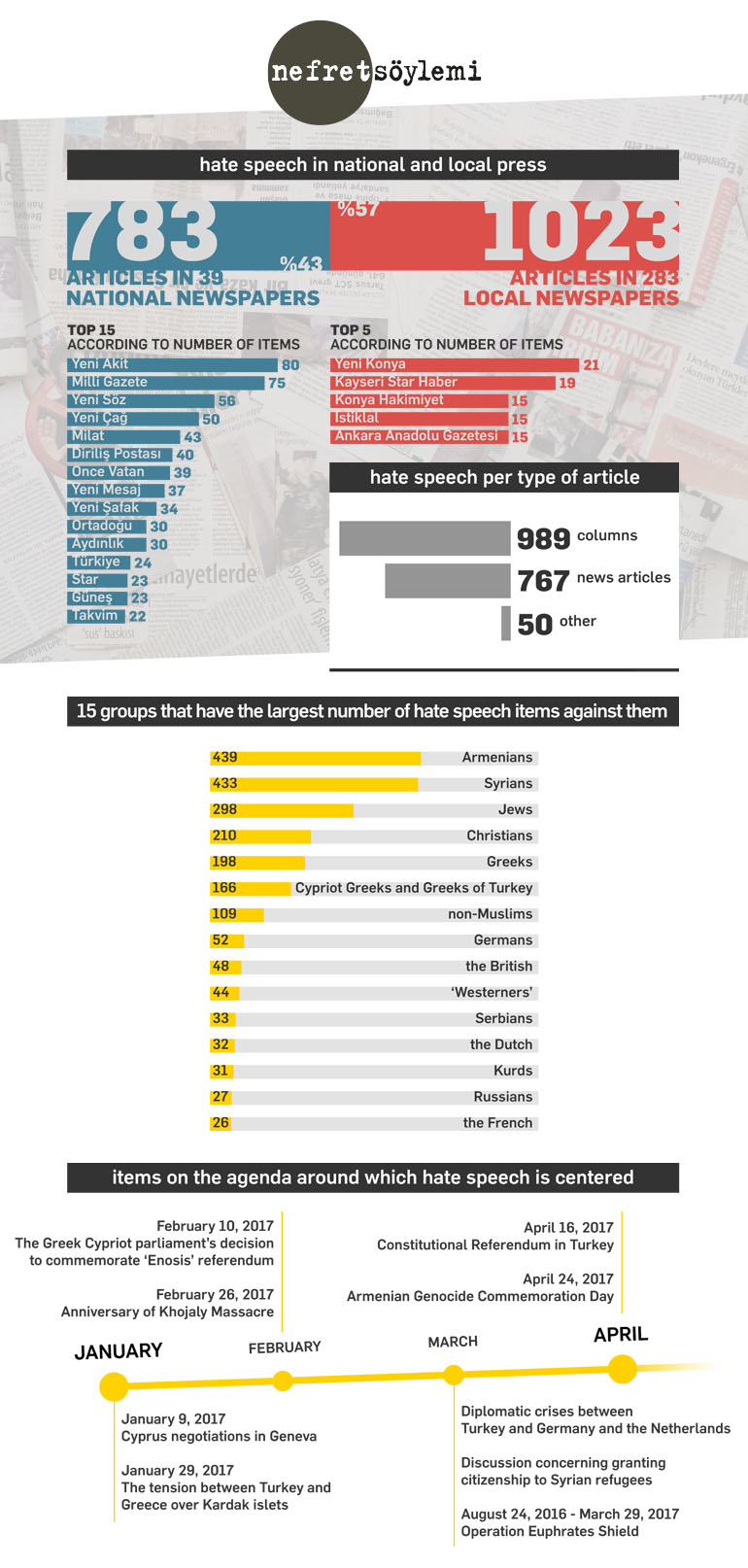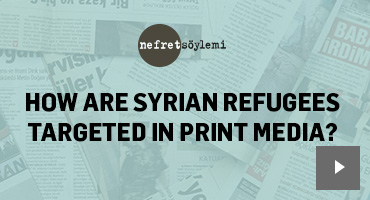In the four-month period of Media Watch on Hate Speech project covering January-February-March-April 2017, 1806 columns and news articles targeting national, ethnic and religious groups had been analyzed. Since 70 publications generated hate speech against more than one group in different categories, these articles are analyzed in accordance with the number of featured groups/categories (more than once). Thus, the total number of analyzed items reached 1876. In all these analyzed content, 2335 hate speech items against 58 groups had been found.
Click here to see the infographic. Click here to read the full report.

The graph below shows the distribution of number of hate speech items per week. Click on the related week for accessing examples of hate speech selected from the weekly findings and analyses of those examples.
January 9-13 January 23-29 January 30 - February 5 February 6-12 February 13-19 January 20-26 February 27 - Mart 5 March 6-12 March 13-19 March 20-26 March 27 - April 2 April 3-9 April 10-16 April 17-23 April 24-30
In January-April 2017,
- Armenians are,
- associated with violence in the articles covering Khojaly Massacre and April 24 Armenian Genocide Commemoration Day and portrayed as enemies;
- targeted in articles and commentaries concerning the dispute between Azerbaijan and Armenia;
- mentioned with PKK and ASALA and identified with ‘terrorism’;
- labeled as the force behind the groups and persons that are systematically portrayed as enemies.
- Syrian refugees are
- systematically mentioned with criminal actions like murder, theft and harassment;
- identified with security concerns and ‘terrorism’;
- presented as responsible for the unfavorable economic condition and unemployment;
- labeled as a threat against Turkey’s demographic structure and generally as source of unease and ‘tension’;
- especially Syrian refugee women presented as a threat against ‘family’ and society;
- subjected to xenophobia in relation to issues like discussions of citizenship, open admission to universities and Operation Euphrates Shield;
- used as a propaganda tool by political figures before April 16 Referendum and turned into scapegoats as print media spread the statements of politicians.
- Jews are
- targeted by way of using a generalized Jewish identity instead of using specific names referring to persons/institutions like “State of Israel”, “Israel” or “Israeli Security Forces”;
- identified with violence and portrayed as enemies in articles covering Israel-Palestine conflict and incidents in Al-Aqsa Mosque;
- presented as ‘the hidden power’ in conspiracy theories and portrayed as ‘a threat against Turkey’;
- associated with many persons and institutions that are mentioned with unfavorable references in media; Jewish identity is used as an expression of insult.
- Christians are
- targeted by way of defining the US, European countries and the EU, which are pointed as threats, as well as Germany and the Netherlands, with whom Turkey had diplomatic crises, on the basis of Christian identity;
- marginalized in reference to unfavorable current issues and verses of Quran;
- presented as ‘a threat against Turkey’s national security’ together with Jews.
- Greeks are
- targeted because of the crisis between Turkey and Greece over Chief of Turkish General Staff Hulusi Akar’s visit to Kardak Islets on the 21st anniversary of ‘Kardak Crisis’ and the rejection of extradition of some soldiers who took refuge in Greece after the coup attempt on July 15;
- labeled as ‘a source of threat for Cypriot Turks’ along with Cypriot Greeks in articles covering Cyprus talks held in Geneva in January;
- presented as ‘natural enemy’ in criticism against CHP MP Hüsnü Bozkurt who said “If ‘yes’ campaign wins on April 16, we would go to Samsun and chase all of you to the sea in Izmir.”
- April 16 Referendum, which was the most important item on the agenda, caused the groups listed above and also non-Muslims, Netherlanders, Germans, ‘Westerners’ and Europeans, which are subjected to hate speech less compared to those groups, to be targeted. The main reason for targeting these groups were the diplomatic crises that erupted after Germany and the Netherlands didn’t allow representatives of Turkish government to hold referendum rallies in Europe and the claim that these countries were campaigning for ‘no’. The word ‘giaour’ was frequently used in covering the crises with European countries and enmity against non-Muslims was incited.
Click for accessing all articles and columns that are identified to contain hate speech.




